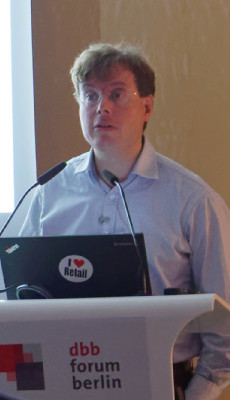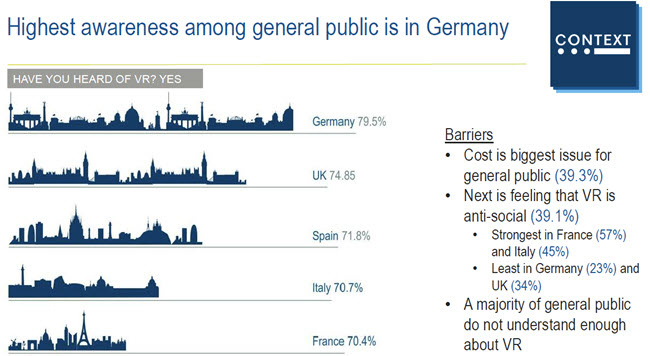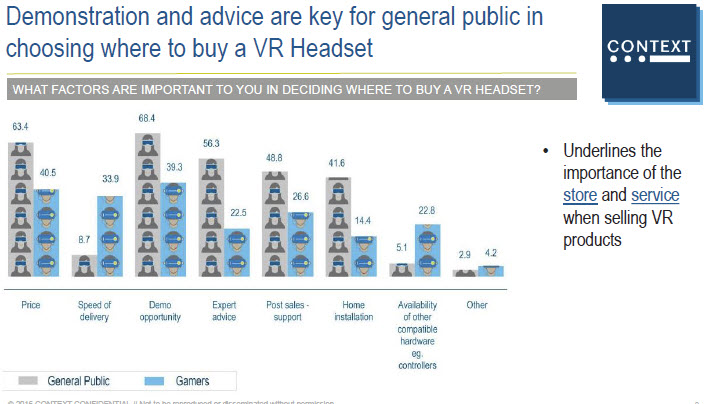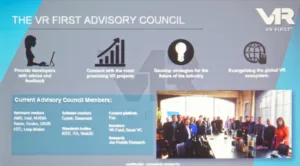Context held a meeting at a downtown conference venue during IBC to talk about VR and AR. The company has established a group including AMD, Oculus, John Lewis, Exertis, Retail Week and Dell to try to understand the development of AR and VR in Europe.
Jonathan Wagstaff of Context said that he believes that this is the year that VR has been democratised – it has developed from having the cost of a house twenty years ago, to very low pricing today. Cardboard has opened people’s eye to VR and helped to enable the development of the market. Of course, its not just the headset cost that has come down, and PCs are getting fast enough to support good quality VR.
PC gaming has been developing. There is a view that the PC market is dead or dying, but PC gaming has been a big growth category and every brand is trying to get into this, now (as we saw at IFA).
Turning to serious applications, Duke University had a “Walk again” project, that helped people who are paraplegic to re-develop bodily control and functions as well as regaining sensations. Wagstaff asked Oculus to keep the Rift open source to allow this kind of development in academic circles.
Wagstaff likes the ‘Big Screen’ beta that allows you to see a PC screen or, more importantly, multiple screens. Each user can access the screens of other participants. Context believes this kind of application will be important. Education is also an important potential market for the use of VR.
Turning to the market, Context believes that gaming notebooks are 2.6% of the market by volume, but around 7% by value.
VR First Looks to Expand the Market
 Ferhan Özkan. Image:MekoFerhan Özkan is from Crytek which has developed software for software and talked about a project to promote VR called “VR First”. His company surveyed 200 universities and research centres to find out about interest in VR. 27% already offer VR course, with 61% planning courses, while only 12% don’t offer courses. Many of the existing courses are in games development and other related areas, but this is changing.
Ferhan Özkan. Image:MekoFerhan Özkan is from Crytek which has developed software for software and talked about a project to promote VR called “VR First”. His company surveyed 200 universities and research centres to find out about interest in VR. 27% already offer VR course, with 61% planning courses, while only 12% don’t offer courses. Many of the existing courses are in games development and other related areas, but this is changing.
The group also checked the installed base of hardware. 40% of the institutions have high end PCs and headsets, and the rest have PCs or headsets, but not both. The average number of headsets available is just 1.5 per institution, so there is a big opportunity to supply these establishments. 67% have Oculus, 15% have Gear VR, 11% Vive, 4% OSVR and 3% have others.
Turning to AR devices, penetration is just 5% because of cost. 24% of respondents have trackers, controllers and haptic devices and 14% of the market have Leap Motion sensors. On that basis, there are 51 students per headset at universities.
New tools are needed and VR First is developing in that direction.
VR Can Expand a Lot
By 2020 there will be 300,000 developers and employees in the VR industry, the VR First group believes.
VR First is creating a consortium to develop the industry. VR First wants to establish a partner network to help develop connections between participants in the market. It also wants to help to develop new vertical markets and coordinate industry and academia. It also wants to help creators become successful entrepreneurs.
The group is trying to position VR First-certified labs as a kind of ‘VR library’ with the idea that once you are a member, all is free. The group wants labs to be as accessible as possible.
There are 424 academic institutions that have been contacted since the start in January and more than 200 have said that they have a VR lab in their university. 14 labs have been confirmed as VR First labs.
The community is mainly a learning and academic community at the moment, but there is an expectation that content creation will be the biggest segment of growth next year. Start-ups are developing (especially in San Francisco and Los Angeles) and the aim of VR First is to help start ups elsewhere.
Running the group is an Advisory council, with members from companies in chips, software, standards bodies, VCs, content platforms, and also research (from our friends, Jon Peddie Research). Hundreds of headsets have been donated to the project to help develop the ‘killer app’ for VR.
Standardisation is needed and to help with that, the group is trying to coordinate to develop certified systems. Özkan said that the South Korean government is investing a lot of money $86.9 million to help develop VR.
A VR Model of Rome
 Dr Matthew Nicholls, a college friend of Wagstaff, is from the University of Reading and has used VR to develop a 3D model of Rome. The model was designed to give access for academic use, but is also popular with general interest audiences. His model is based on Rome before the Goths sacked the city about the 3rd century AD. The model was built in Sketch Up software but Cinema 4D was used when the model got to be too big. Getting data on the history was time consuming. For example, there was a huge marble map of Rome made in the third for tax purposes, but was broken, so has had to be painstakingly put together.
Dr Matthew Nicholls, a college friend of Wagstaff, is from the University of Reading and has used VR to develop a 3D model of Rome. The model was designed to give access for academic use, but is also popular with general interest audiences. His model is based on Rome before the Goths sacked the city about the 3rd century AD. The model was built in Sketch Up software but Cinema 4D was used when the model got to be too big. Getting data on the history was time consuming. For example, there was a huge marble map of Rome made in the third for tax purposes, but was broken, so has had to be painstakingly put together.
The model can be rendered in very high visual quality now. Nicholls has taught using the model and smartphones and he said that the availability and ubiquity of smartphones make a real difference to the acceptance of VR. Pedagogically, there is a ‘Wow’ factor that draws students into further research, Nicholls said. The immersion of VR really changes the experience of the model.
The model took six years to build, but has now been included into a Unity-based model so that it can be viewed using an Oculus Rift.
 There are also very high quality rendering systems such as Lumion. Academics these days have outreach targets and so he will put the model on the Reading FutureLearn Mooc. There will be a five week course.
There are also very high quality rendering systems such as Lumion. Academics these days have outreach targets and so he will put the model on the Reading FutureLearn Mooc. There will be a five week course.
Nicholls believes that VR will have a major transformative effect on the view of ancient history.
Context Has Conducted Research on VR in Europe
Adam Simon of Context then showed some extracts from a consumer survey that was published in July. 2,500 consumers were surveyed in June 2016. VR is pretty well recognised as a concept and Simon said that VR is in your ‘minds eye’. 80% of gamers know a lot about it and those in Germany know more about it than in other countries. However, the variation in awareness is not huge – it goes from 79% in Germany to 70% in France. In Southern Europe, putting a headset on is seen as antisocial behaviour and that may have a negative impact on adoption.

Simon showed a list of deterrents that would stop consumers from buying. Cost is the most important barrier, but being seen to be antisocial is the second most important factor. For a good experience, you need dedicated space which can be a challenge. Motion sickness is still a negative factor but it’s much better than it used to be, Simon said. However, no level of logical understanding that you are not in a real world will help you if you have vertigo.

People are prepared to spend a lot, especially gamers, Context found. “When does the price level meet the expectation of buyers”, he asked? When headsets are over €500, the market is small. A key point, then is how quick prices will fall. When will supply meet demand? In different countries, there are different expectations and market sweet spots so there will be a significant variation in adoption around Europe.
The survey asked “What most excites you about VR – sports, films or experiences?”. Very few people say that nothing excites them.
There are serious uses of VR too. The empathetic use of VR, for example to replicate the sensations of a diabetic coma, could be important going forward. Simon said that feeling what others feel is an important issue. However, there are also attractive applications in history (The landing on the moon etc.) and Fox sports has been doing work on delivering VR sporting events.

One of the key points for consumers is getting advice and demo facilities for sales as well as support which makes this a real ‘omnichannel’ opportunity. The best opportunity at the channel level is for specialist technology retailers, Simon concluded.

